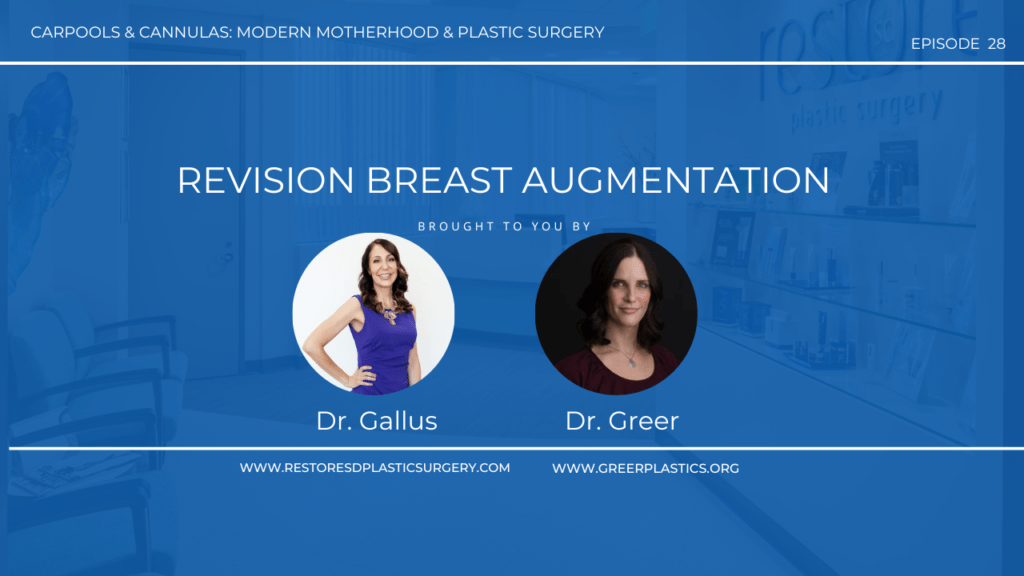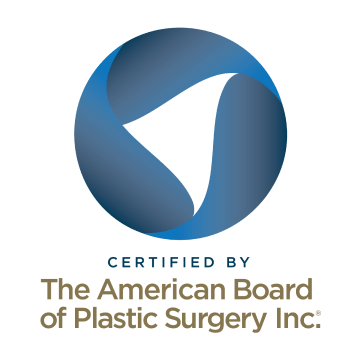In this episode of Carpools & Cannulas, San Diego plastic surgeon Dr. Katerina Gallus of Restore SD Plastic Surgery and Dr. Jennifer Greer of Greer Plastic Surgery in Cleveland, OH, talk about the second time you may need breast implant surgery. What are the most common reasons to exchange breast implants? Do you really need new implants every 10 years? Hear from these two board-certified plastic surgeons on all the factors that go into revision breast surgery.
Transcript
Dr. Gallus:
Hey everybody, it’s Dr. Gallus with Restore SD Plastic Surgery. Ready to do another round of Carpools and Cannulas with Dr. Greer who should be joining me shortly. And tonight we’re gonna talk about breast implant revision surgery. So super excited about that. So there she is because I think we both do a fair amount of this. As soon as she requests I will get her on. Go live.
Dr. Gallus:
I feel like I have super weird lighting this evening, but that’s fine. Hey,
Dr. Greer:
Okay.
Dr. Gallus:
Hey, how are you? I’m good. It feels like it’s been forever since I just saw you in person, even though it was like a couple weeks ago, right?
Dr. Greer:
It’s been like a month.
Dr. Gallus:
Has it? It’s been like two weeks.
Dr. Greer:
Yeah, I mean it’s been at least a month cause we had ASPS at the end of last month and now we’re halfway through November.
Dr. Gallus:
So like two weeks.
Dr. Greer:
Well the meeting was two weeks ago.
Dr. Gallus:
Yeah, that’s what I said.
Dr. Greer:
Yeah. And now it was like a week before that so maybe three weeks.
Dr. Gallus:
Okay.
Dr. Greer:
Not so so long.
Dr. Gallus:
It seems like a long time ago but whatever. Yeah. And it was good to see you.
Dr. Greer:
I know it’s good to see you as well and like a hundred other amazing women plastic surgeons.
Dr. Gallus:
Yeah. It was a good time. I’m just actually watching some of the on-demand stuff now or not on-demand but some of the stuff that was recorded because I felt like I ran around the whole time and then didn’t get to go to every lecture or thing that I wanted to go to.
Dr. Greer:
Yes. Although it was funny, like the things that I remember, like Ashley Amalfi is Tegaderm bra, so my scrub tech today, she’s like Dr. Vanek across the hall is doing the craziest thing. He’s using this Ioban as like a bra. I’m like yeah, I know where he learned and I was at that lecture.
Dr. Gallus:
Yeah. Yeah I know I might use that actually. Just have to find the right patient for it. Yeah. And I met one of those patients today honestly. Um, so we were gonna talk about breast implant revision on topic.
Dr. Greer:
I mean we both do a ton of breast surgery and revisions happen eventually.
Dr. Gallus:
Yes. So, um, yeah so I thought about it for her. She’s not exactly sure what she wants to do anyway. Hey, Dr. Sunita. For people who just need, she just needs like a, she had an augmentation like several years ago in a different state and one nipple is a little bit lower than the other one. She didn’t have a lift at the time and one of her concerns is that asymmetry and you could do, I said you could just do the lift, you could just reposition the nipple under local honestly. But then she has , hey, she has saline implants which um, she just doesn’t like. So that’s another decision factor. Um, she doesn’t like, the way she can feel them laterally. She can kind of feel like it’s a Ziploc bag full of water kind of sensation and it’s rippley. So you know, if you’re gonna do that then you’re changing out the implants. Maybe you could, you know, resupport the implant and then Tegaderm the nipple up because it really only needs to go like a centimeter. So yeah.
Dr. Greer:
I actually have a primary upcoming up where one nipple is a little bit lower. And that might be a nice option…
Dr. Gallus:
Right.
Dr. Greer:
To just release them both off the muscle a little bit. So when you’re releasing, you’ve got the pec muscle, you got the breast tissue, you release the breast tissue off the muscle and then tape it up a little bit higher with the Tegaderm bra and it stays up a little bit higher. That actually might be a really nice option for her.
Dr. Gallus:
Yeah. Cause sometimes it is really the one side and do you really wanna put an incision on one side…
Dr. Greer:
Right. We talked about that. I was like I don’t wanna make an incision on one side and it’s really obvious compared to the other. That might be a really good option actually. I’ll just have to warn her, “Hey, you’re gonna have plastic tape on you for three weeks.” It’ll be here for it because it’s winter.
Dr. Gallus:
Yeah, it is kinda odd to wear plastic, basically saran wrap, bra for three weeks, whatever. So, okay. Well I figured we can narrow it down by talking about people who have implants in and want implants back in. Yeah. Like not out permanently. So you know, sometimes people aren’t sure what they wanna do and then that’s a totally different conversation. But if you have implants then um, the easiest people are people who have implants in. There’s nothing wrong with their implants. It’s just been 10 years and I tell them to wait.
Dr. Greer:
Yeah. I was like, you’re good. It’s not like an oil change guys. You don’t hit your 10,000 miles and your air filter has to be changed. It’s well and now we have high resolution ultrasound in the office, which I think was a game changer because I would always tell patients, you know, if you have saline you’re gonna know if they deflate because it will shrink with silicone, you don’t really know. And then do we wanna order an MRI that gets kind of expensive but now we all are starting to get ultrasound in the office so we can just take a peek at your implants and tell if there intact.
Dr. Gallus:
Yes. But if they’re not bothering you and there’s nothing going on with them, then absolutely. Maybe don’t mess with them. That would be yeah.
Dr. Greer:
Come back in three years.
Dr. Gallus:
That’s the easiest. Then I have people who, like you were saying saline implants. That’s probably the most common reason for implant revision with saline implants is rupture, right? They automatically know there’s, there’s a problem because their whole implant deflates. And so you have one flat breast and one that’s not. Um, do you see a lot of those or…
Dr. Greer:
I do. I see a ton of those and hi Amanda who waved to us. Yeah. Where they’ll come in and one side’s really asymmetric and it’s the most annoying thing ever because you have to stuff one side of your bra all the time. So I love deflating that other side of the office and then at least they’re symmetric while we’re waiting to do things. Although I’ve had one or two patients decline that and say thanks, they’ll stick with the padding.
Dr. Gallus:
Yeah. I’ve had patients just hang out like that until they just get on the surgery schedule sooner rather than later. Right. Um, just because you know, nobody wants to walk around one deflated breast. So I tell my patients about, I would say about 50% of my, saline patients when they have a deflated saline implant, that’s why they’re having another surgery. They stick with saline because they know how it feels and they’re good with it. And then the other 50% switched to silicone because the reason they got saline was when they had it put in, they were either too young or, it was during a time where you couldn’t get silicone implants.
Dr. Greer:
Right. Actually silicone implants weren’t available until the end of my residency. I mean, I wanna say it was like the fourth year they were back on the market for cosmetic, not just reconstructive. And the, the temporary hiatus was just because we wanted more data. There weren’t any actual problems or increased risks with silicone compared to saline. But they’ve been back on the market for cosmetics now for a good 12 years. And those are definitely the implants I use most. They feel the nicest, they’re the softest.
Dr. Gallus:
Right. So I do tell them, you know, you have the option to switch to silicone if you want. If you don’t you can stay with saline because you know what you’ve got. But most primary, people are just getting an augmentation for the first time, are doing silicone.
Dr. Greer:
Yep. And I have to tell you guys, if you are coming in for a consultation about your current implants and you bring in your implant ID card, you get like a super extra gold star in my book. I’m always super impressed when people have that thing. They’re like, it’s 20 years old. But it tells me the exact style of implants, how full they are, what size. It makes a huge difference. Although I will say I think plastic surgeons get pretty good at guessing implant size. Like we could work at a carnival, be a really screwed up carnival, but we get pretty good, you know, I’ve definitely guessed right on the nose or within range many times.
Dr. Gallus:
Yeah. I think the times I’ve guessed wildly incorrectly is when the patient is so confident but doesn’t have proof. So I had people tell me, oh yes I absolutely have 500 cc implants in. And then you get in there and you’re like, wait, these are 250. Like how did you, how were you so wrong? I had somebody beg me to deflate her saline implants and she had silicone in there and I was like, mm yeah these aren’t gonna deflate. So how are you so confident that you have something in there that’s not there without proof? And I’ve learned to take that as a, you know, I just say, okay, well that’s your best guess. I’ve had people with their implants placed in other countries, um, like ugh. It’s the CSI of trying to figure out what’s in there.
Dr. Greer:
It is. And then there’s always the whole textured versus not textured. And the reason this is important guys is because of breast implant associated anaplastic large cell lymphoma, BIALCL. It has been happening so far as we know only in people who have had textured implants at some point in time. So if we know they’re textured and they’re above the muscle where it’s easy to take out the entire capsule, we like to do that because we think it’s probably preventative. If they’re under the muscle, it’s a lot harder to get that capsule off the ribs without doing damage. But then at least we know what to warn you for. But then sometimes we’ll go in and it’s like, oh, I didn’t realize these were textured, we didn’t talk about capsulectomy.
Dr. Gallus:
Right. I’ve had that happen. I just tell ’em, listen, if we really don’t have any idea what’s in there and they’re textured, I’m gonna try to get the whole capsule out. Which again, as you pointed out, is so much easier if there’s sub glandular implants. However, I would say over time sub glandular implants, at least as from what I’ve seen, don’t hold up as well. Like tend to fall with the, with the breast tissue. Like they just come down.
Dr. Greer:
Yeah. And the sub-muscular sometimes just stay…
Dr. Gallus:
And the breast tissue and the breast tissue falls off.
Dr. Greer:
Yeah. It’s kinda an adventure seeing what’s in there.
Dr. Gallus:
Yeah. So I recently, let’s see, last week I took out implants that were completely ruptured. Like so ruptured. I couldn’t, I mean they were placed in the nineties so not a surprise, but grade one capsule is like very thin, you know.
Dr. Greer:
Parting it out.
Dr. Gallus:
Out. Yeah. I got it all out. But the capsule was thin and then the implant was just barely any shell. Like completely gonzo. Those are always tough and you know, those have had to have been ruptured for a while but sometimes when they rupture you get a capsular contracture or you get, you know, calcifications and they have coconuts like rock hard, rock hard. But um, not always. So it’s always an adventure. Still don’t even know what was in there because there was no way to even weigh it. It was just a straight goo mess.
Dr. Greer:
Yeah. Implants get really gooey. The older generation ones, the silicone was less highly cross-linked. So more like honey, the newer ones, it’s a cohesive gel but leave those in for 20 years and they may soften up. We’re not really sure. It’s fun. And the capsule you guys, it’s the scar tissue around the implant. It can be anywhere from a couple cells thick where it’s like trying to dissect out tissue paper to like a nice thick leathery capsule, which is my easier to cut out.
Dr. Gallus:
Right. Absolutely. So yeah. So I have, let’s see. Say what would you say your most common reason is for women to come in for implant exchange?
Dr. Greer:
I would say it’s more, it’s changes in their breast over time. Okay. So often they had implants before they had kids and then afterward things either dropped or they’ve gained weight or their bodies changed that the implants are too big for their frame. So it’s usually that things have changed over time. Once in a while they know that things are ruptured.
Dr. Gallus:
Yeah. I would say too that the saline patients almost always it’s a rupture, but my silicone patients generally it’s a size change or they know they need a lift so they want to change, tweak something the implants have been in for a long time. So if you’re gonna do a lift, just exchange them and have a fresh start there and maybe go up or down a little bit in size. And I think it depends how old the implants are. Honestly, I feel like 20 year old implants tend to run in the 250 cc range. At least in southern California. 10 years ago they’re more likely to be 400 ccs, 500 ccs.
Dr. Greer:
It’s all trend.
Dr. Gallus:
Yeah. And then I think it’s swinging, you know, the pendulum swinging for smaller implants again. But you know, there’s always outliers so.
Dr. Greer:
Yep. And I’ve had a couple patients, I’ve had exactly two who came in and they were like, I just thought they would be bigger and higher. That’s always a hard one guys because bigger means heavier, which means gravity.
Dr. Gallus:
Yes. Yeah.
Dr. Greer:
That’s usually what I’ll bring in the big guns and used GalaFLEX to support.
Dr. Gallus:
Right. And I was just talking to somebody about that today because it was, her implants are mostly fine. So kind of trying to tease out what she wants if anything right now. Because she’s also fairly, if you had your implants placed let’s say in your twenties and now in your late thirties, you might not wanna mess with them because you’re gonna likely need to do it again. Um, so you better have a, like a really be able to tell me what it is you want changed. And it started to boil into having the implant sit higher and I’m like well they are submuscular and they kind of are where they are. So you’re looking at using some sort of internal support to prop them up as much as possible. And that’s…
Dr. Greer:
It does help. It does help a bit. It gets ’em a little bit higher. Mm-hmm.
Dr. Gallus:
Yeah. Holds it up there. But yeah, it’s, that’s a sometimes So again I try to explain to patients and I’m sure you do too, you’re putting the implants, you’re kind of centering them behind the breast at least where the breast should be. Yeah. I don’t know who came up with the idea of a footprint for a breast but…
Dr. Greer:
Well I mean I guess it’s just where the breast is attached to the chest wall. It doesn’t always stay there. It gets kind of long but you know, so if you lift the breast up, there’s a crease at the top guys and then everybody’s got the crease at the bottom, the inframammary fold and between those two is the footprint of the breast and it stays ideally within that footprint. Short of things like raising the whole footprint of the breast by removing some tissue off the inframammary fold, then we get into some more complex techniques. But yeah.
Dr. Gallus:
So I’ve seen the lowering of the fold. Um, I think yeah when we start messing with a footprint you start adding a whole other um, level of complexity to the breast and sometimes you can do that, but a lot of times you don’t want to. I would say the most common um, request is to have your breast closer together. Right. So that’s cleavage. But where if…
Dr. Greer:
You don’t want that, you actually don’t have that.
Dr. Gallus:
If you push your breast immediately, so towards the center of your chest you can kind of see where it’s attached to your chest wall and it really, the implant should not go past that. If it does, your breast will slide out. Your nipples will be past going in, out facing outwards. So we don’t want that. You definitely don’t want your chest to connect in the center,
Dr. Greer:
See not the mastia because you’ve gotta have the pectoralis muscle insertion is what keeps those implants separated. And if you try to go more menial than that, you end up with one continuous pocket, which is not awesome. You’ve probably seen it on Botched.
Dr. Gallus:
Yes. It’s like those jog bras that have no separation. You’re just one big breast uniboob. Nobody wants that. So Yeah. So you have to make some sacrifices. You have to kind of appreciate what you can do with your own native breast. I tell them that you do get an appearance of cleavage because you’re increasing the volume of here. But we’re not,
Dr. Greer:
You still need a pushup off. You want that super tight.
Dr. Gallus:
Yeah. Up, up and up and up. Yes.
Dr. Greer:
And then you know, women often want a higher upper pole, which with the implants that’s what happens. The implant goes above the upper pole and it raises it. But if you’re just doing a lift, the upper pole doesn’t go any higher. So I think women don’t, there’s like a little bit of a misconception about what the result’s gonna look like without adding an implant, adding fat, adding mesh.
Dr. Gallus:
Yes, I agree. So I’ve seen that when people think they just wanna lift and they kind of shove like I just wanna lift and shove everything up. Yeah, you are. It’s more like picking it , you’re like raising it a little bit but you’re not shoving up upper pole. And definitely an implant will… if you want that upper pole, that upper half of your breast to be kind of full. Um, you need a, you need an implant almost always. You can, you can do a little bit with that definitely depends on how much fat you have, how much breast tissue you have have. Um, but it’ll still look more natural than that rounded. I call it an orange county look because Southern California. But yeah, if you want people to know that you have implants, then that’s definitely a higher more projecting implant. Yeah. And I do have people who want to do that too. If you wanna go up in size, but you don’t need, you don’t want an implant that’s like now way out here, you can change profiles but then again it helps to know what you have in there first.
Dr. Greer:
Right. And if you don’t know it, it doesn’t help at all. And then after a certain size they’re all high profile anyway. I mean really after about 285 or so, most people don’t have a super wide chest to accommodate that size. So your high profile after that.
Dr. Gallus:
Yeah you’re definitely. So then that means, um, what we’re talking about is how much the implant’s gonna add to how much you stick out from your chest wall. So how much you’re projecting. Um, which is, you know, one of the nice aspects of having an implant is that you have more projection and more kind of upper fullness. So great if you wanna wear strapless dress, you wanna wear, you know, a bikini without support. A lot of women tell me they like implants because then they don’t have to wear a bra, which is, you know, cool I guess.
Dr. Greer:
Theoretically but don’t do it all the time because those implants are heavy and the tissue stretches.
Dr. Gallus:
Yes, that’s true. True. And then lately I’ve had a run of people, um, a run of people that have been like, I don’t know what bra I wear. I feel like people have stopped, they’re wearing bralettes or jog bras or camisoles and they’re like yeah we’re trying to drill down to like a 34 C is is become less, I don’t know, it’s less universal at least in my patient population.
Dr. Greer:
I’m loving the comment there if I could but I think cuz it’s your TikTok, I can’t but yes they do. And congrats and I’m excited for you. I, you know, that actually reminds me of, cuz I just did this technique, I do this technique all the time. So if you do a lift often we take out a little wedge of tissue over the inferior pole but with people who wanna maintain volume, we can take that tissue and kind of tuck it up over the upper pole and that does add a little bit of upper pole fullness. Right. Without meshing, without an implant. I call it an auto augmentation, what is it, Ribeiro technique? Yeah.
Dr. Gallus:
Yeah, yeah. Probably pronouncing that wrong. Yes. I think that’s helpful. I definitely don’t like if you are trying to maintain as much volume as possible, I start, you know, I feel like we’re queens of not throwing anything away. So
Dr. Greer:
Yeah we save it, we just rearrange it and tuck it up and it looks pretty good.
Dr. Gallus:
Yeah, definitely. So, okay. What do you do when someone comes in and you know they have ruptured implants? Do you do anything different or?
Dr. Greer:
Well ruptured silicone implants are very, very messy. Actually the very first time I operated at the surgery center I do all my cases at, I took out ruptured implants and it got so gooey they had to strip the floors and re wax them cuz the floors were slippery. Silicone is slippery guys and it, it gets all over the instruments, it gets all over your gloves. So I always make sure that we have clindamycin on hand, although there’s been a shortage to make sure wide, which has been a little tough. Um, because that will wash out and then I always try to do a capsulectomy if I can so it’s not all over the place.
Dr. Gallus:
Yeah, so yeah, I mean I think it’s helpful to know if it’s ruptured so that you can be prepared. Um, but sometimes you, you know, you’re not gonna know. It’s a surprise when the implants aren’t very old. It’s usually kind of surprising. I’ve done um, best uh, ruptured implant unprepared was somebody I was taking them out under local. Um, so that was fun. But again it was a newer implant so they tend not to be as honey-like inside and more like a gummy bear. So much easier.
Dr. Greer:
Actually the last surprise rupture I took out, we only knew it was ruptured because there was an air bubble in the implant and it took me, it took me a couple minutes of squeezing the implant looking really closely and there’s one little pinhole rupture that let the air in but otherwise you wouldn’t have known.
Dr. Gallus:
Yes, I’ve seen that as well. So that’s good if you can um, you know, get that out and put a new implant in and kind of move along. I’ve done that for sure. You know it’s ruptured, it shows up ruptured on a mammogram or whatnot and so then it’s time to do the exchange. And it’s also important to know that the implant companies will replace the implants if you let them kno. So you have to ship ’em back in and prove that they’re ruptured. There’s some paperwork we fill out but they’ll at least cover the cost of the replaced implants.
Dr. Greer:
Yes. And that’s the warranty that comes with all implants. All of the device manufacturers have them. I think they’re usually up to about 10 years and after that the rupture rate goes up. So the warranties…
Dr. Gallus:
Uh, most of them warranty now for longer.
Dr. Greer:
Are they longer now? They used to be. Okay. So clearly Dr. Gallus reads the literature on her implants way more than I do.
Dr. Gallus:
I feel like I had to do an update talk for ASPS on them a couple years ago. But yeah, they’ll warranty for the lives of the implant. For capsular contracture your cutoff is 10 years. So I just saw somebody that was nine years in had her current cap card, I can’t remember where she had had it done, but I was like, you can, you know, you can go see multiple people, try to figure out what it is you wanna do, but um, just make sure you get in under that 10 year window. Otherwise the companies aren’t gonna budge on that.
Dr. Greer:
Yeah. And of course the implant company has to still be in existence. I’ve taken out a lot of McGahn implants which aren’t.
Dr. Gallus:
Yes.
Dr. Greer:
And then I think the, I took out Dow Corning implants ones, those were old.
Dr. Gallus:
Those are very old. I’ve seen those. Those are fun.
Dr. Greer:
Yep. So there’s a lot What in, is Inamed still in the market or is that the…
Dr. Gallus:
Inamed? No, Inamed , became McGahn, then Inamed, then Allergan.
Dr. Greer:
Okay. Yeah. So it’s like then you gotta track down the warranty program and you gotta have your info. Yeah. So it’s complicated.
Dr. Gallus:
Yeah. So I think it’s just the newer implants that have that kind of warranty. I’ve had people who had ruptured implants that were part of studies but they like no longer like contract that so they just have to cut cost. That’s why you should your card just public service announcement.
Dr. Greer:
Card and and also when we educate people, it’s like right on the information sheet, this is cosmetic, future surgeries are cosmetic, they’re not covered by insurance. You’re gonna have to pay out of pocket and the cost is usually the same or a little bit more than your primary aug.
Dr. Gallus:
Right, right. Yeah. You have to mentally prepare for that.
Dr. Greer:
Yeah. Because it’s not generally any shorter of a surgery. Often it’s more involved you have to pay for new implants. So it’s all the same costs.
Dr. Gallus:
Yeah. Yeah. I tell people the most common reasons for implant exchange is size change or rupture or cap. con. Those are the three most common listed and it’s not, there’s no time limit on any of that, but the longer you have the implants longer one of those things, it’s gonna pop up.
Dr. Greer:
Exactly. And then once in a great while I’ll have an early revision either because an implant didn’t drop in a place enough or dropped a little bit too far.
Dr. Gallus:
Right. And that…
Dr. Greer:
Happens once every couple of years where I’ll go back in and just either release a little bit of the capsule or tack the inframammary, fold up a little bit.
Dr. Gallus:
Right. Yeah. Just to correct that little bit of asymmetry. Yeah. Nice. Yeah. So implants in a nutshell.
Dr. Greer:
Well I actually had a request in my DMs so maybe we can do it next time to talk about um, gynecomastia surgery.
Dr. Gallus:
Wow. Yeah, we have not had a discussion about that.
Dr. Greer:
Oh my gosh. I think one of my staff members daughters got engaged because my techs are blowing up. If you keep hearing the ding, I just picture with a hand like this. So I think that’s what happened.
Dr. Gallus:
That’s awesome. Super exciting. Cool. Yeah, let’s talk about gynecomastia. That will be super perfect. I did a lot of stuff in the military.
Dr. Greer:
And let’s see, that’ll be two weeks. It’ll be Cyber Monday, right?
Dr. Gallus:
Yeah, yeah. It’ll be right after Thanksgiving, right? Yes. Okay.
Dr. Greer:
Thanksgiving’s next week.
Dr. Gallus:
Gosh. I know. I am so not ready. I’m trying to say hi to everybody.
Dr. Greer:
I know.
Dr. Gallus:
All right. Cool. Well I think that wraps it up. If you have implants and you’re concerned about ’em, go see your board certified plastic surgeon to find out what needs to happen next.
Dr. Greer:
Yep. And if we didn’t do your implants, we’re still really happy to see you for a consultation. Do an ultrasound, tell you if everything looks good or if you’re ready for a revision.
Dr. Gallus:
Yep. Sounds good. All right. Have a good night.
Dr. Greer:
You too.
Dr. Gallus:
Okay. All right. See you.
About Restore SD & Dr. Katerina Gallus
As the Director of Restore SD Plastic Surgery, board certified female San Diego plastic surgeon Dr. Katerina Gallus has over 15 years of experience helping patients enjoy head to toe rejuvenation with face, breast and body procedures. After a successful career as a Navy plastic surgeon, Dr. Gallus founded her San Diego plastic surgery center Restore SD Plastic Surgery with the intention of creating a welcoming space for anyone seeking cosmetic enhancement.
Restore SD Plastic Surgery offers popular facial rejuvenation procedures like facelift & neck lift, facial fat grafting, and eyelid lift; breast augmentation with implants, breast lifts or breast reduction; body contouring procedures such as tummy tuck, liposuction, mommy makeover, and Brazilian butt lift (BBL), as well as aesthetician services, BOTOX, injectable fillers, and laser treatments.
Dr. Gallus and her highly-experienced aesthetics team are here to help you look and feel your best! To schedule a personal consultation, please contact us online or call our San Diego office at (858) 224-2281 today.









